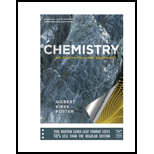
To find:
Moles and atoms of titanium in the given compounds
Answer to Problem 2.65QA
Solution:
a) 0.125 moles of FeTiO3 contains 0.125 moles and 7.53 * 1022 atoms of Titanium.
b) 0.125 moles of TiCl4 contains 0.125 moles and 7.53 * 1022 atoms of Titanium
c) 0.125 moles of Ti2O3 contains 0.25 moles and 1.51 * 1023 atoms of Titanium.
d) 0.125 moles of Ti3O5 contains 0.375 moles and 2.26 * 1023 atoms of Titanium.
Explanation of Solution
Calculations:
a) 0.125 mol of FeTiO3
In one molecule of FeTiO3, there is one atom of Ti. Therefore, we can say that the mole ratio between FeTiO3: Ti is 1:1. Now, we have the mole to mole ratio, and moles of FeTiO3; so, we can calculate the moles of Ti using the dimensional analysis method.
So, 0.125 mol of FeTiO3 contains 0.125 mol of Ti.
Now, we convert moles into atoms. We know that in every 1 mol of substance we have 6.023 * 1023 molecules or atoms of the given substance which is equal to
Using this conversion factor, we will convert 0.125 mol of Ti to atoms of Ti.
So, 0.125 moles of FeTiO3 contains 7.53 * 1022 atoms of Ti.
b) 0.125 mol of TiCl4
In one molecule of TiCl4, there is one atom of Ti. Therefore, we can say the mole ratio between TiCl4: Ti is 1:1. Now, we have the mole to mole ratio and moles of TiCl4; so, we can calculate the moles of Ti using the dimensional analysis method.
So, 0.125 mol of TiCl4 contains 0.125 mol of Ti.
We know that 1 mol of Ti = 6.023 * 1023 atoms of Ti. Using this conversion factor, we will convert 0.125 mol of Ti to atoms of Ti.
So, 0.125 moles of TiCl4 contains 7.53 * 1022 atoms of Ti.
c) 0.125 mol of Ti2O3
In one molecule of Ti2O3, there are two atoms of Ti. Therefore, we can say the mole ratio between Ti2O3: Ti is 1:2. Now, we have the mole to mole ratio and moles of Ti2O3; so, we can calculate the moles of Ti using the dimensional analysis method.
So, 0.125 mol of Ti2O3 contains 0.250 mol of Ti.
We know that 1 mol of Ti = 6.023 * 1023 atoms of Ti. Using this conversion factor, we will convert 0.250 mol of Ti to atoms of Ti.
So, 0.125 moles of Ti2O3 contains 1.51 * 1023 atoms of Ti.
d) 0.125 mol of Ti3O5
In one molecule of Ti3O5, there are three atoms of Ti. Therefore, we can say the mole ratio between Ti3O5: Ti is 1:3. Now, we have the mole to mole ratio and moles of Ti3O5; so we can calculate the moles of Ti using the dimensional analysis method.
So, 0.125 mol of Ti3O5 contains 0.375 mol of Ti.
We know that 1 mol of Ti = 6.023 * 1023 atoms of Ti. Using this conversion factor, we will convert 0.375 mol of Ti to atoms of Ti.
So 0.125 moles of Ti3O5 contains 2.26 * 1023 atoms of Ti.
Conclusion:
a) 0.125 moles of FeTiO3 contains 0.125 moles and 7.53 * 1022 atoms of Titanium.
b) 0.125 moles of TiCl4 contains 0.125 moles and 7.53 * 1022 atoms of Titanium
c) 0.125 moles of Ti2O3 contains 0.250 moles and 1.51 * 1023 atoms of Titanium.
d) 0.125 moles of Ti3O5 contains 0.375 moles and 2.26 * 1023 atoms of Titanium
Want to see more full solutions like this?
Chapter 2 Solutions
Chemistry: An Atoms-Focused Approach
 ChemistryChemistryISBN:9781305957404Author:Steven S. Zumdahl, Susan A. Zumdahl, Donald J. DeCostePublisher:Cengage Learning
ChemistryChemistryISBN:9781305957404Author:Steven S. Zumdahl, Susan A. Zumdahl, Donald J. DeCostePublisher:Cengage Learning ChemistryChemistryISBN:9781259911156Author:Raymond Chang Dr., Jason Overby ProfessorPublisher:McGraw-Hill Education
ChemistryChemistryISBN:9781259911156Author:Raymond Chang Dr., Jason Overby ProfessorPublisher:McGraw-Hill Education Principles of Instrumental AnalysisChemistryISBN:9781305577213Author:Douglas A. Skoog, F. James Holler, Stanley R. CrouchPublisher:Cengage Learning
Principles of Instrumental AnalysisChemistryISBN:9781305577213Author:Douglas A. Skoog, F. James Holler, Stanley R. CrouchPublisher:Cengage Learning Organic ChemistryChemistryISBN:9780078021558Author:Janice Gorzynski Smith Dr.Publisher:McGraw-Hill Education
Organic ChemistryChemistryISBN:9780078021558Author:Janice Gorzynski Smith Dr.Publisher:McGraw-Hill Education Chemistry: Principles and ReactionsChemistryISBN:9781305079373Author:William L. Masterton, Cecile N. HurleyPublisher:Cengage Learning
Chemistry: Principles and ReactionsChemistryISBN:9781305079373Author:William L. Masterton, Cecile N. HurleyPublisher:Cengage Learning Elementary Principles of Chemical Processes, Bind...ChemistryISBN:9781118431221Author:Richard M. Felder, Ronald W. Rousseau, Lisa G. BullardPublisher:WILEY
Elementary Principles of Chemical Processes, Bind...ChemistryISBN:9781118431221Author:Richard M. Felder, Ronald W. Rousseau, Lisa G. BullardPublisher:WILEY





